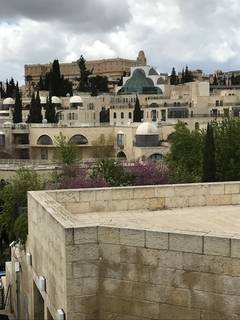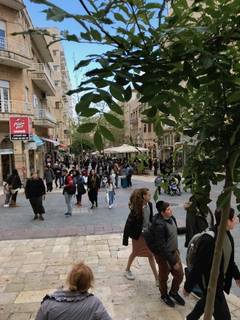06/20/2019 10:47:50 AM
Installment #6
Raymond (see last week's entry) is the arranger of music for the Choir of Jerusalem's Great Synagogue where, in the 70's, I occasionally sang. So I decided to attend services there this AM. Services started at 8:00, & ended at 11:45 (And you think OUR services are long???).
(If you're not interested in a description of services at one of Israel's biggest synagogues, you can skip the next couple of paragraphs.)

The VENUE: The building was completed in 1982. The Sanctuary seats 1,400. There is beautiful stained glass over the ark, & more in the back of the Sanctuary. The ark itself is probably the single most imposing feature; probably about 15 feet wide, it contains two rows of Torah scrolls, with about ten scrolls on each row. Twenty Torahs that I could see! There may have been more, obscured by the ark curtain. (Photo by Tania Nagar)
The SERVICE: The HAZZAN did a full Amidah repetition in both Shacharit & Mussaf, the choir of about 10 men participated in the service throughout. They stood on the Bimah between the HAZZAN and the ark, with their conductor standing right in front of the ark, facing the HAZZAN, which means he actually has his back to the ark. The HALLEL (Psalms 113-118, recited every day of Passover), between choral renditions, cantorial flights of fantasy, and congregational murmurings, lasted half an hour for which the congregation was expected to remain standing! Because it was the first day of Passover, the Song of Songs was added to the service and speedily chanted from a parchment scroll. And as in all Orthodox congregations, twice during services, KOHANIM mounted the Bimah to bless the congregation. There was no sermon, at which I was surprised...but not disappointed.
Sunday we started out by taking a photo of the view from our hotel window. Not awesome, but nice.
 Then we walked to the Old City. For some reason, there was an incredibly long line of pedestrians waiting to get into the Jaffa gate. Got a good shot of Linda in front of the Tower of David.
Then we walked to the Old City. For some reason, there was an incredibly long line of pedestrians waiting to get into the Jaffa gate. Got a good shot of Linda in front of the Tower of David.
Instead of following the crowd to the Kotel (Western Wall), we continued straight to the SHUK (also spelled SHOUK), on a mission. We had to buy gifts for the "kids" and for a few others as well (Christian and Jewish). After we checked some prices, without actually ENTERING one store, we entered another. The salesman was friendly but persistent, and half an hour later, we left the store with more merchandise than we had intended to buy. And while Linda & I were consulting ("Do we REALLY want/need this item?"), the salesman talked to another customer in German & another in French!!
 Leaving the Jaffa Gate, took a photo looking towards the King David Hotel. Many of the buildings look almost new. Then I proceeded to Jaffa Rd. Since 2011, cars & trucks have been banned from what used to be Jerusalem's busiest thoroughfare. It is now for pedestrians and light rail only. Turned off Jaffa Rd to go to another busy---though narrower---thoroughfare, Ben Yehuda Street. As always, it was bustling with people of all ages & nationalities.
Leaving the Jaffa Gate, took a photo looking towards the King David Hotel. Many of the buildings look almost new. Then I proceeded to Jaffa Rd. Since 2011, cars & trucks have been banned from what used to be Jerusalem's busiest thoroughfare. It is now for pedestrians and light rail only. Turned off Jaffa Rd to go to another busy---though narrower---thoroughfare, Ben Yehuda Street. As always, it was bustling with people of all ages & nationalities.
Although most Israeli cities & towns have a major street named for him, many American Jews have no idea who he was. A contemporary of Theodor Herzl, Eliezer Ben Yehuda (born Eliezer Perlman, 1858-1922) did for the Hebrew language what Herzl did for the land of Israel. Against furious opposition both from secularists (who insisted that the Jewish people already HAVE a language: Yiddish) and the very religious, who felt that the use of Hebrew, the language of the prophets, for mundane matters was a desecration, he spearheaded its revival as a living language, which it had not been since Biblcal times.
There is a story, probably apocryphal, that at a meeting with Herzl, Ben Yehuda told Herzl of his plan to revive the long-dead Hebrew language. According to the story, Herzl remarked, "And they call ME crazy!"
As you know, he eventually succeeded gloriously, though posthumously. Hence all the streets in his memory. There is no other example of a language so long unspoken (except in prayer) being so completely revived and modernized. BTW, the ultra-Orthodox to this day speak Yiddish in their daily lives, reserving Hebrew for prayer & study.

After dinner, we walked back to Ben Yehuda to purchase a new Tallit bag for Linda. It was fairly late in the evening, & many of the JUDAICA shops were closed. We went into an open one, and were fortunate in that the merchant had about 50 for us to choose from. We were VERY surprised when he asked, "Is it for a man or a woman?"A more Orthodox merchant, say, one in Mea She'arim, would never consider selling a Tallit, Tallit bag or ANY such ritual object to a woman, and might have even asked us to leave. Before the question, I was expecting to tell him we were buying it for a friend. But that fiction was made unnecessary by the man's question.
This time, there was a bit of negotiating, and we think we got a good price, though I'm sure the merchant didn't lose money. After the purchase, the man shared with us a midrash about Moshe Rabbeinu, Moses Our Teacher. A teacher as well as merchant.




